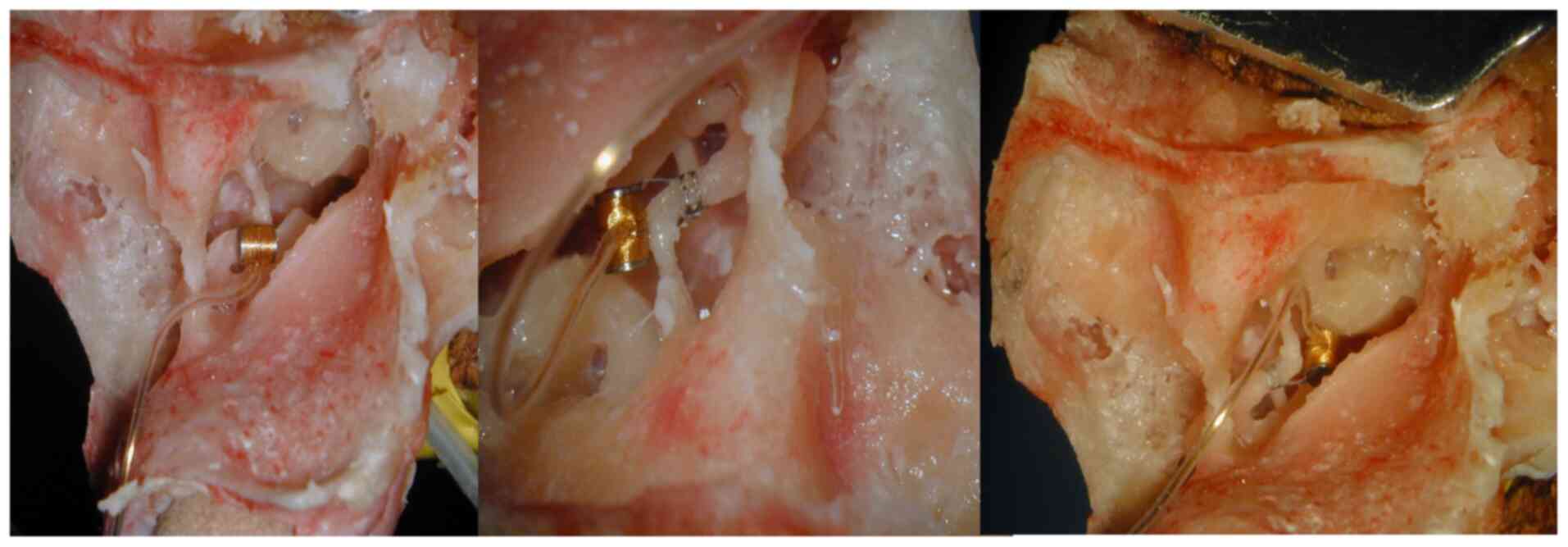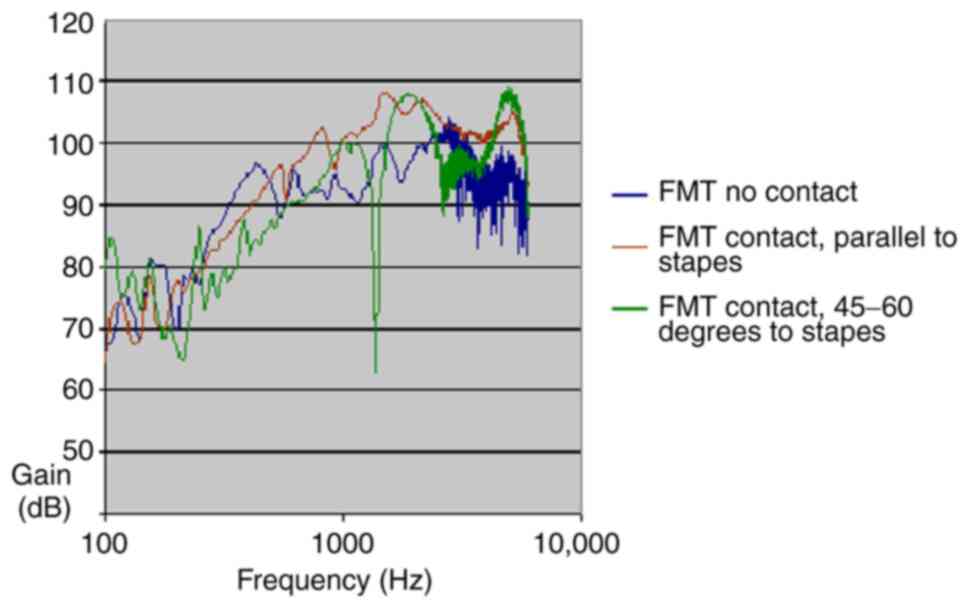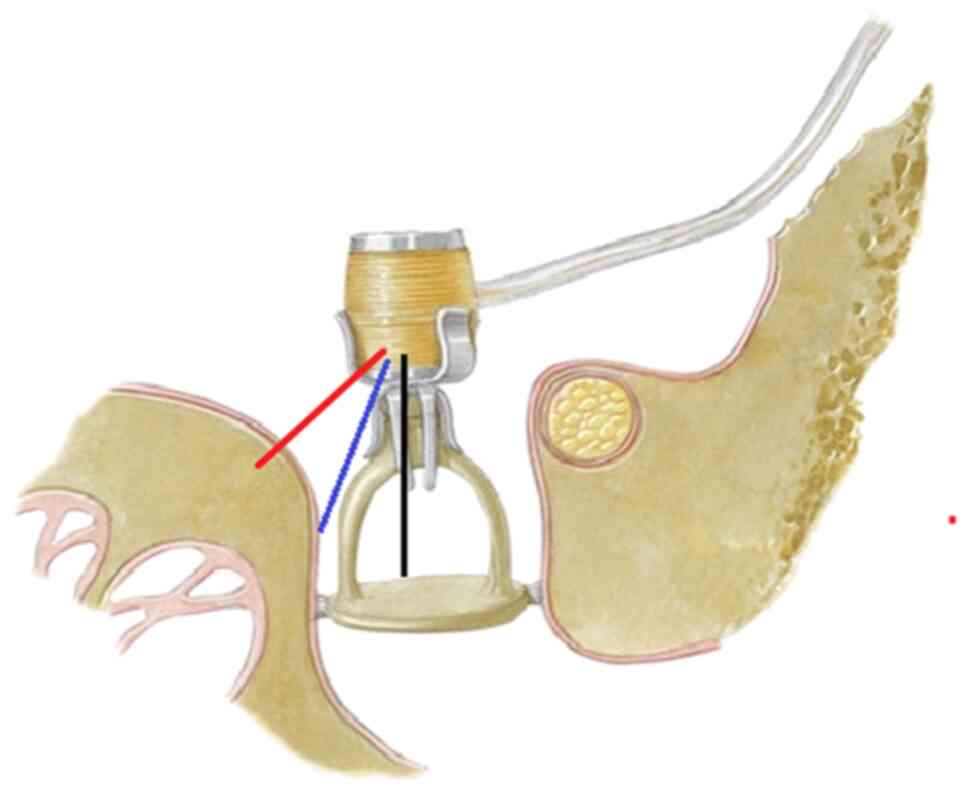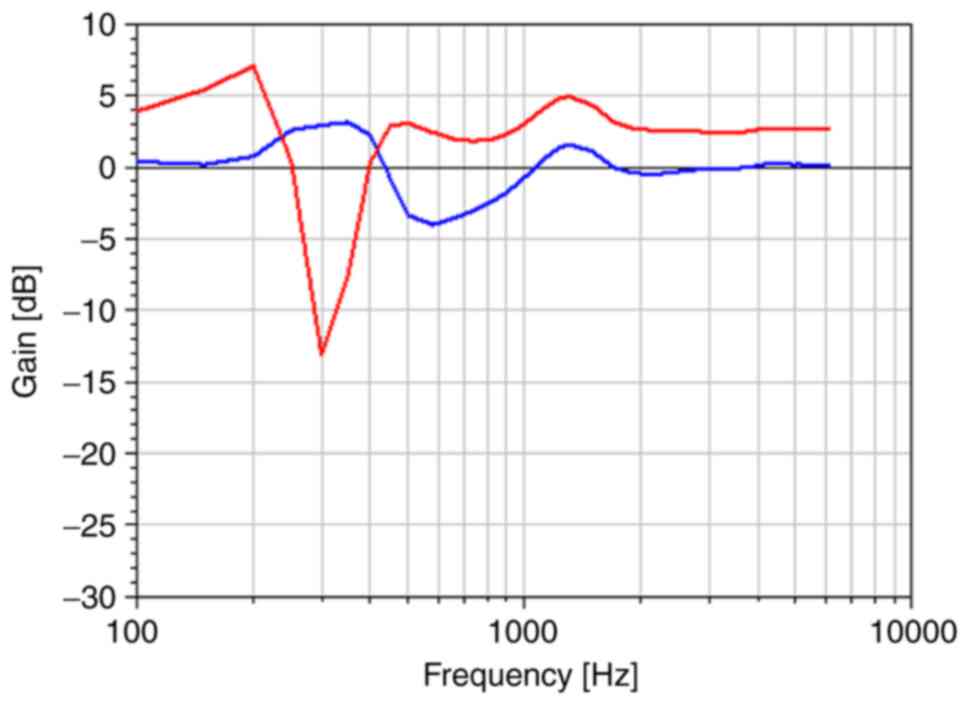|
1
|
Prendergast PJ, Ferris P, Rice HJ and
Blayney AW: Vibro-acoustic modelling of the outer and middle ear
using the finite-element method. Audiol Neurotol. 4:185–191.
1999.PubMed/NCBI View Article : Google Scholar
|
|
2
|
Lighthill J: Biomechanics of hearing
sensitivity. J Vib Acoust. 113:1–13. 1991.
|
|
3
|
von Békésy G: Experiments in Hearing.
Mc-Graw-Hill, New York, NY, 1960.
|
|
4
|
Stinson MR: The spatial distribution of
sound pressure within scaled replicas of the human ear canal. J
Acoust Soc Am. 78:1596–1602. 1985.PubMed/NCBI View
Article : Google Scholar
|
|
5
|
Zwislocki JJ: Analysis of middle-ear
function. J Acoust Soc Am. 34:1514–1523. 1962.
|
|
6
|
Zwislocki JJ: Normal function of the
middle ear and its measurement. Audiology. 21:4–14. 1982.PubMed/NCBI View Article : Google Scholar
|
|
7
|
Funnell WR and Laszlo CA: Modeling of the
cat eardrum as a thin shell using the finite-element method. J
Acoust Soc Am. 63:1461–1467. 1978.PubMed/NCBI View
Article : Google Scholar
|
|
8
|
Williams KR and Lesser TH: A finite
element analysis of the natural frequencies of vibration of the
human tympanic membrane. Part I. Br J Audiol. 24:319–327.
1990.PubMed/NCBI View Article : Google Scholar
|
|
9
|
Trifu S: Neuroendocrine insights into
burnout syndrome. Acta Endocrinol (Bucur). 15:404–405.
2019.PubMed/NCBI View Article : Google Scholar
|
|
10
|
Trifu S, Vladuti A and Popescu A:
Neuroendocrine aspects of pregnancy and postpartum depression. Acta
Endocrinol (Bucur). 15:410–415. 2019.
|
|
11
|
Monsell EM: The mechanism of hearing loss
in Paget's disease of bone. Laryngoscope. 114:598–606.
2004.PubMed/NCBI View Article : Google Scholar
|
|
12
|
Mocanu H: The role of perinatal hearing
screening in the normal development of the Infant's language. In:
Debating Globalization. Identity, Nation and Dialogue. 4th edition.
Boldea I and Sigmirean C (eds). Arhipeleag XXI Press, Tirgu Mures,
pp562-569, 2017.
|
|
13
|
Mocanu H: The economic impact of early
diagnosis of congenital hearing loss. In: Debating Globalization.
Identity, Nation and Dialogue. 4th edition. Boldea I and Sigmirean
C (eds). Arhipeleag XXI Press, Tirgu Mures, pp556-561, 2017.
|
|
14
|
Mocanu H and Oncioiu I: The influence of
clinical and environmental risk factors in the etiology of
congenital sensorineural hearing loss in the Romanian population.
Iran J Public Health. 48:2301–2303. 2019.PubMed/NCBI
|
|
15
|
Bornitz M, Hardtke HJ and Zahnert T:
Evaluation of implantable actuators by means of a middle ear
simulation model. Hear Res. 263:145–151. 2010.PubMed/NCBI View Article : Google Scholar
|
|
16
|
Neudert M, Bornitz M, Mocanu H,
Lasurashvili N, Beleites T, Offergeld C and Zahnert T: Feasibility
study of a mechanical Real-time feedback system for optimizing the
sound transfer in the reconstructed middle Ear. Otol Neurotol.
39:e907–e920. 2018.PubMed/NCBI View Article : Google Scholar
|
|
17
|
Schuknecht HF: Pathology of the Ear
(Commonwealth Fund Publications). Harvard University Press,
Cambridge, 1974.
|
|
18
|
Prendergast PJ: Finite element models in
tissue mechanics and orthopaedic implant design. Clin Biomech
(Bristol Avon). 12:343–366. 1997.PubMed/NCBI View Article : Google Scholar
|
|
19
|
Zahnert T, Schmidt R, Hüttenbrink KB and
Hardtke HJ: F-E simulation of the Dresden middle-ear prosthesis.
In: Middle-Ear Mechanics in Research and Otosurgery. Hüttenbrink KB
(eds). University of Technology, Dresden, pp200-206, 1997.
|
|
20
|
Alecu I, Mocanu H and Călin IE:
Intellectual mobility in higher education system. Rom J Mil Med.
120:16–21. 2017.
|
|
21
|
Lesser TH, Williams KR and Blayney AW:
Mechanics and materials in middle ear reconstruction. Clin
Otolaryngol Allied Sci. 16:29–32. 1991.PubMed/NCBI View Article : Google Scholar
|
|
22
|
Wada H, Metoki T and Kobayashi T: Analysis
of dynamic behavior of human middle ear using a finite-element
method. J Acoust Soc Am. 92:3157–3168. 1992.PubMed/NCBI View
Article : Google Scholar
|
|
23
|
Williams KR and Lesser TH: A dynamic and
natural frequency analysis of the Fisch II spandrel using the
finite element method. Clin Otolaryngol Allied Sci. 17:261–270.
1992.PubMed/NCBI View Article : Google Scholar
|
|
24
|
Ladak HM and Funnell WR: Finite-element
modeling of the normal and surgically repaired cat middle ear. J
Acoust Soc Am. 100:933–944. 1996.PubMed/NCBI View
Article : Google Scholar
|
|
25
|
Koike T, Wada H and Kobayashi T: Modeling
of the human middle ear using the finite-element method. J Acoust
Soc Am. 111:1306–1317. 2002.PubMed/NCBI View Article : Google Scholar
|
|
26
|
Beer HJ, Bornitz M, Drescher J, Schmidt R,
Hardtke HJ, Hofmann G, Vogel U, Zahnert T and Hüttenbrink KB:
Finite element modelling of the human eardrum and applications. In:
Middle Ear Mechanics in Research and Otosurgery. Hüttenbrink KB
(ed). Proceedings of the International Workshop on Middle Ear
Mechanics, Dresden, pp40-47, 1997.
|
|
27
|
Williams KR, Blayney AW and Lesser TH:
Mode shapes of a damaged and repaired tympanic membrane as analysed
by the finite element method. Clin Otolaryngol Allied Sci.
22:126–131. 1997.PubMed/NCBI View Article : Google Scholar
|
|
28
|
Eiber A: Mechanical modeling and dynamical
investigation of middle ear. In: Middle-Ear Mechanics in Research
and Otosurgery. Hüttenbrink KB (ed). Proceedings of the
International Workshop on Middle Ear Mechanics, Dresden, pp61-66,
1997.
|
|
29
|
Eiber A: Mechanical modeling and dynamical
behavior of the human middle ear. Audiol Neurotol. 4:170–177.
1999.PubMed/NCBI View Article : Google Scholar
|
|
30
|
Blayney AW, Williams KR and Rice HJ: A
dynamic and harmonic damped finite element analysis model of
stapedotomy. Acta Otolaryngol. 117:269–273. 1997.PubMed/NCBI View Article : Google Scholar
|


















